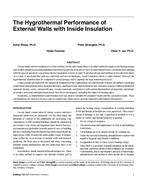Description
On one hand, interior insulation is a risky method. On the other hand, there is no other method to improve the heating energy and comfort situation of existing buildings when their facades are to be preserved. For more than ten years, a team has been dealing with the special questions concerning interior insulation systems in order to develop design and methods of execution for them. As a result, it was found that with new materials and new technologies, inside insulation can be a viable method. However, the hygrothermal situation must be evaluated to avoid damage and to quantify the heat transmission losses. Using a model developed for the numerical simulation of the coupled heat, air, and moisture transfer, the authors calculated temperature and moisture fields, heat flow densities, and hygroscopic and overhygroscopic moisture contents. Different insulation materials (foams, wools, calcium silicates, wooden materials, and plasters) with various thermophysical properties and details of window area and embedded beam heads have been investigated, including the impact of heating pipes. In parallel, a comprehensive experimental work was done to validate the computer model and the calculated results. These investigations are shown to be necessary to confirm new ideas and to develop materials with improved properties.
Authors: Horst Stopp, Ph.D.; Peter Strangeld, Ph.D.; Heiko Fechner; Peter HÃupl, Ph.D.
Citation: Thermal Performance of the Exterior Envelopes of Buildings VIII
Keywords: December, Florida, 2001
Citation: Thermal Performance of the Exterior Envelopes of Whole Buildings VIII
Product Details
- Published:
- 2001
- File Size:
- 1 file , 21 MB
- Product Code(s):
- D-8006




